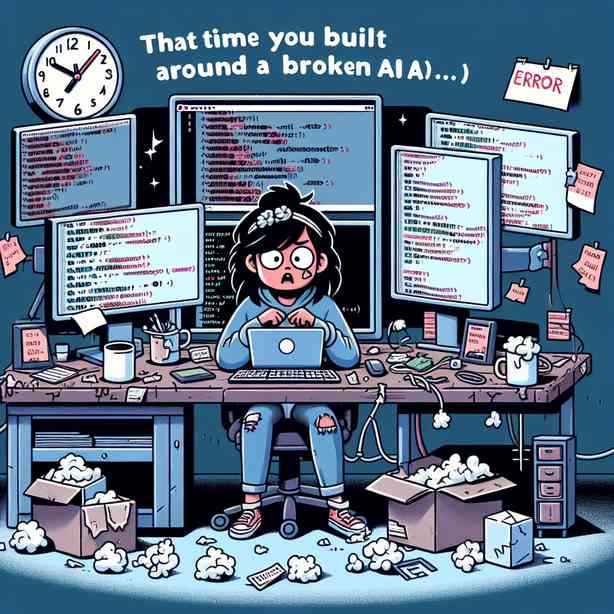
Building around a broken API can be a daunting task for many developers, especially when the API you rely on for crucial features or functionalities fails to deliver on its promises. An API (Application Programming Interface) is essentially a set of rules and protocols that allow different software systems to communicate with each other. When an API is broken, it means that the communication between the systems has been disrupted, which can lead to a variety of issues, from minor inconveniences to major setbacks.
In this article, we will delve into the challenges of working with a broken API and explore practical strategies for building around it effectively. By the end of this discussion, you will be equipped with the knowledge to tackle similar situations with confidence.
To begin with, it’s essential to identify what constitutes a broken API. Often, this could mean that the API is down due to server issues, has changed its response format without notice, or is frequently returning errors. Regardless of the specific issue, the result is the same: your application’s functionality is compromised. In a world where user experience is paramount, this can lead to frustration and loss of trust in your product.
The first step in handling a broken API is to analyze the root cause of the problem. Is it a temporary outage, or is the API provider undergoing significant changes in their service? By reaching out to the API provider, you can often gain insights into the status of the API. Additionally, checking the provider’s status page or developer forums can provide real-time updates. Understanding the nature of the problem is the cornerstone of developing a workaround.
Once you have a clear understanding of the issues at hand, it’s time to consider implementing caching mechanisms. Caching can be extremely beneficial when dealing with an unstable API. By storing the responses of API calls locally for a specified amount of time, you can minimize the impact of downtime. For instance, if your application queries data from the API every minute, consider keeping that data available for a short duration, so if the API fails during the next call, your application can still function using the cached data.
Moving forward, it’s worth exploring the option of redundant APIs. If your application relies heavily on a single API that constantly experiences issues, it might be viable to integrate an alternative API that offers similar functionalities. This approach not only diversifies your data sources but also reduces the dependency on a single point of failure. However, implementing a redundant API comes with its own set of challenges, such as managing differences in data formats or ensuring synchronization between the two APIs.
Another strategy that can be employed is to enhance your error handling capabilities. This involves creating a more robust system to manage failed API calls graciously. Instead of throwing a disruptive error message to the user, consider implementing fallback mechanisms. For instance, inform users that the data they requested is currently unavailable and provide them with an option to try again later, or display an informative message with cached data instead. This approach can significantly enhance user experience, as it provides them with more control and understanding of the situation.
Additionally, documenting the behavior of the broken API can be incredibly useful, not only for your own understanding but also for future reference. Whenever an issue arises, take the time to note down the symptoms, your analysis of the problem, and the workarounds you implemented. This documentation can serve as a valuable resource for yourself and your team or anyone else who might face similar problems in the future.
Moreover, consider building a monitoring system that alerts you when the API behaves unexpectedly. By setting up tools that track response times and error rates, you can receive notifications the moment an anomaly occurs. This proactive approach allows you to respond quickly to issues and coordinate with your team to implement temporary solutions, ultimately minimizing downtime for your end users.
In parallel with these technical strategies, communication plays a critical role in managing a broken API. Keeping your users informed about the problems and steps you are taking to resolve them can significantly improve their overall experience. Transparency builds trust, and users will appreciate knowing that you are actively working on a solution.
As you navigate the complexities of working with a broken API, it’s crucial to keep an eye on long-term solutions. If an API is consistently unreliable, it might be time to prioritize finding alternative services that better meet your needs. Conduct a thorough evaluation of your current API provider and look for others that have a solid track record of uptime and support.
In conclusion, building around a broken API presents numerous challenges that require careful navigation. By employing caching strategies, integrating redundant APIs, enhancing error handling, documenting behaviors, and establishing monitoring systems, you can create a more resilient application that maintains functionality even in the face of adversity. Communication is equally important in maintaining user trust and ensuring a positive experience, even when the back-end systems are not performing as expected.
While dealing with a broken API can feel overwhelming, remember that it is a shared experience in the software development community. By learning from these challenges and implementing effective strategies, you can enhance your skills and prepare for future obstacles. With ongoing vigilance and adaptability, you can turn the difficulties of working with a broken API into lessons that will ultimately fortify your development process. Cultivating a proactive mindset and a toolkit of effective strategies will empower you and your team to thrive in the face of any technical challenges.


